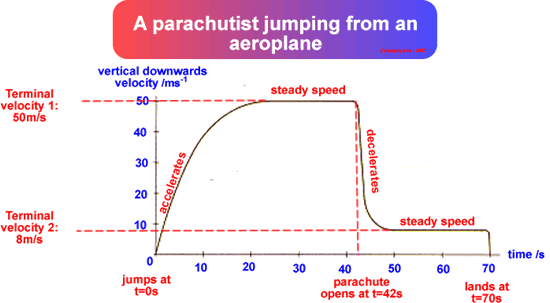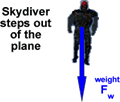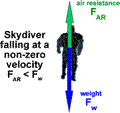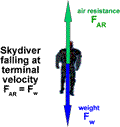Terminal Velocity
The downward force acting on the skydiver - his weight - Fw
The force of gravity acts between all masses. It is an attractive force - you are pulled towards all other masses. The force of gravity is proportional to the product of the masses it acts between... therefore the only mass you notice being attracted to is the Earth!
On Earth each kilogram of mass is pulled with a force of 10N (the weight of that mass) along a line drawn towards the centre of the Earth.
A skydiver has this force exerted on him/her even though there is no direct contact between the skydiver and the Earth. This type of force, when two objects exert forces on one another even though they are not touching, is known as a noncontact force.
According to Newton's second law, the acceleration of an object as produced by a force is directly proportional to the magnitude of the net force, in the same direction as the net force, and inversely proportional to the mass of the object; or
Fnet = ma
The weight of an object is a product of its mass and acceleration due to gravity or
w = mg
The acceleration due to gravity (g) near the Earth's surface is a 9.81 m/s2 (at GCSE rounded to 10 m/s2 ) . So, the weight of an object depends on how much mass an object has.
The upward force acing on a skydiver - the Air Resistance - FAR
Air resistance is due to an object colliding with molecules of air.
A falling skydiver collides with air molecules during the downward fall. These air molecules create a force pushing upward which is opposite to the skydiver's direction of travel - this is called 'drag'.
The amount of air resistance or drag encountered by the skydiver depends on three factors:
1: The speed of the skydiver.
The faster he goes the more air particles he collides with per second therefore the bigger the air resistance will be. If he is not moving the air resistance will be zero.
2: The area of intercept of the skydiver.
The area of intercept of the skydiver is the cross section of him (at right angles to his direction of travel). The larger this is the more air particles he will bump into per second and the higher the air resistance will be. If he is very streamlined the area of intercept will be small and there will be less air resistance than if he was bulky with lots of areas that could trap pockets of air as he fell.
 A skydiver who has his arms and legs spread out (usually referred to as the arch position) will meet with more air resistance than one who falls straight down down. The skydiver can therefore control air resistance to a certain degree by repositioning him/herself. A skydiver who has his arms and legs spread out (usually referred to as the arch position) will meet with more air resistance than one who falls straight down down. The skydiver can therefore control air resistance to a certain degree by repositioning him/herself.
|
 Opening a parachute dramatically increases this area of intercept. Opening the parachute can make the skydiver decelerate rapidly by making the force of air resistance bigger than the force of weight. Opening a parachute dramatically increases this area of intercept. Opening the parachute can make the skydiver decelerate rapidly by making the force of air resistance bigger than the force of weight.
|
3. The air density
The greater the density of the air (it is less dense at higher altitudes - the air is said to be 'thinner') the more air particles the skydiver will bump into each second making the air resistance greater.
Terminal Velocity
The resultant force of gravity minus air resistance acting on the skydiver as he fall makes him accelerate according to the equation F = ma.
So,
FW - FAR = ma
As long as Fw is greater than the FAR the skydiver will accelerate - get faster.
If Fw is smaller than FAR s/he will decelerate - undergo negative acceleration - get slower.

 When s/he steps out of the plane his/her vertical velocity component is 0 m/s so air resistance is zero. That means only the force of gravity acting on his mass - his weight - is acting. That means his vertical velocity rapidly increases. When s/he steps out of the plane his/her vertical velocity component is 0 m/s so air resistance is zero. That means only the force of gravity acting on his mass - his weight - is acting. That means his vertical velocity rapidly increases. |
 As the speed of the skydiver increases every second as he or she plummets towards the ground there is an increase in air resistance (as this gets bigger as his/her speed increases). This results in a smaller net force acting on the skydiver. S/he is still getting faster, but not at the same rate as s/he did initially. Look at the graph representing how the vertical velocity changes duing the fall. You can see that the gradient decreases as the speed increases. As the speed of the skydiver increases every second as he or she plummets towards the ground there is an increase in air resistance (as this gets bigger as his/her speed increases). This results in a smaller net force acting on the skydiver. S/he is still getting faster, but not at the same rate as s/he did initially. Look at the graph representing how the vertical velocity changes duing the fall. You can see that the gradient decreases as the speed increases. |
 Eventually the gradient of the graph is zero. Eventually the gradient of the graph is zero.
That happens when Fw = FAR
No net force means no acceleration and that means the velocity will remain constant. It is the final velocity - terminal velocity. |
How a Parachute Works
 When the parachute is opened the force of air resistance becomes much, much greater than the force of gravity. When the parachute is opened the force of air resistance becomes much, much greater than the force of gravity.
The net force on the descending skydiver now has an acceleration that points upward - negative acceleration or deceleration.
This causes a rapid decrease in the skydiver's velocity.
Look at the graph representing how the vertical velocity changes duing the fall. You can see that the gradient becomes strongly negative when the parachute is opened. |

As the speed of descent decreases, the amount of air resistance also falls, until once again a terminal velocity is reached because Fw = FAR. This second terminal velocity is now slow enough to allow the skydiver can land safely on terra firma without his legs snapping in two - assuming s/he lands correctly.



 A skydiver who has his arms and legs spread out (usually referred to as the arch position) will meet with more air resistance than one who falls straight down down. The skydiver can therefore control air resistance to a certain degree by repositioning him/herself.
A skydiver who has his arms and legs spread out (usually referred to as the arch position) will meet with more air resistance than one who falls straight down down. The skydiver can therefore control air resistance to a certain degree by repositioning him/herself.  Opening a parachute dramatically increases this area of intercept. Opening the parachute can make the skydiver decelerate rapidly by making the force of air resistance bigger than the force of weight.
Opening a parachute dramatically increases this area of intercept. Opening the parachute can make the skydiver decelerate rapidly by making the force of air resistance bigger than the force of weight.
 When s/he steps out of the plane his/her vertical velocity component is 0 m/s so air resistance is zero. That means only the force of gravity acting on his mass - his weight - is acting. That means his vertical velocity rapidly increases.
When s/he steps out of the plane his/her vertical velocity component is 0 m/s so air resistance is zero. That means only the force of gravity acting on his mass - his weight - is acting. That means his vertical velocity rapidly increases.  As the speed of the skydiver increases every second as he or she plummets towards the ground there is an increase in air resistance (as this gets bigger as his/her speed increases). This results in a smaller net force acting on the skydiver. S/he is still getting faster, but not at the same rate as s/he did initially. Look at the graph representing how the vertical velocity changes duing the fall. You can see that the gradient decreases as the speed increases.
As the speed of the skydiver increases every second as he or she plummets towards the ground there is an increase in air resistance (as this gets bigger as his/her speed increases). This results in a smaller net force acting on the skydiver. S/he is still getting faster, but not at the same rate as s/he did initially. Look at the graph representing how the vertical velocity changes duing the fall. You can see that the gradient decreases as the speed increases.  Eventually the gradient of the graph is zero.
Eventually the gradient of the graph is zero.  When the parachute is opened the force of air resistance becomes much, much greater than the force of gravity.
When the parachute is opened the force of air resistance becomes much, much greater than the force of gravity. 



